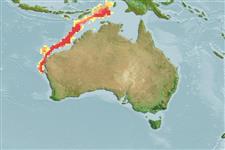Elasmobranchii (sharks and rays) >
Rajiformes (Skates and rays) >
Anacanthobatidae (Smooth skates)
Etymology: bulbicauda: Name from Latin ‘bulbus’ for swelling and ‘cauda’ for tail or appendage, with reference to the flattened expansion of the tail near its tip.
More on authors: Last & Séret.
Environment: milieu / climate zone / depth range / distribution range
Ecology
Marine; demersal; depth range 150 - 1125 m (Ref. 75174). Tropical; 5°S - 27°S, 111°E - 134°E (Ref. 75174)
Indo-West Pacific: Australia (Shark Bay) and eastern Indonesia (Refs. 75174, 114953).
Size / Weight / Age
Maturity: Lm ? range ? - 43 cm
Max length : 43.3 cm TL male/unsexed; (Ref. 75174); 56.0 cm TL (female)
Short description
Identification keys | Morphology | Morphometrics
This species is distinguished by the following combination of characters: moderate-sized disc, its width at anterior orbit 5.2-7.8 times mouth width; moderately elongate to short tail, its postcloacal length 79-170% of disc length; relatively large eyes with orbit diameter 4.7-8.8 in horizontal snout and 6.7-10.6 in head lengths, respectively; distal portion of tail expanded laterally in specimens exceeding about 28 cm TL (130 mm DW), width of tail near tip 1.3-2.2 times tail width at its midlength; pectoral-fin radials 66-71; moderate-sized pelvic fins, anterior lobe 12.1-18.1% TL; anterior pelvic-fin lobe rather broad-based, width 1.7-3.2 in distance between pelvic-fin origins; caudal fin rudimentary; tooth rows 20-28, in each jaw of adults; with teeth of adult males with greatly elongated conical cusps; 25-31 abdominal vertebral centra; 148-171 total centra; dorsal surface pale pinkish brown, ventral surface uniformly pale (Ref. 75174).
Found on outer continental shelf and upper slope. Presumably feeds on small fishes and invertebrates. Males reaches maturity at ca. 43 cm TL; smallest neonatal juvenile 13 cm TL (Ref. 114953)
Life cycle and mating behavior
Maturity | Reproduction | Spawning | Eggs | Fecundity | Larvae
Last, P.R. and B. Séret, 2008. Three new legskates of the genus Sinobatis (Rajoidei: Anacanthobatidae) from the Indo-West Pacific. Zootaxa 1671:33-58. (Ref. 75174)
IUCN Red List Status (Ref. 130435: Version 2024-1)
Threat to humans
Harmless
Human uses
Tools
Special reports
Download XML
Internet sources
Estimates based on models
Preferred temperature (Ref.
123201): 7.8 - 14.6, mean 11.1 °C (based on 40 cells).
Phylogenetic diversity index (Ref.
82804): PD
50 = 0.5020 [Uniqueness, from 0.5 = low to 2.0 = high].
Bayesian length-weight: a=0.01000 (0.00244 - 0.04107), b=3.04 (2.81 - 3.27), in cm total length, based on all LWR estimates for this body shape (Ref.
93245).
Trophic level (Ref.
69278): 3.8 ±0.6 se; based on size and trophs of closest relatives
Fishing Vulnerability (Ref.
59153): Moderate vulnerability (42 of 100).
